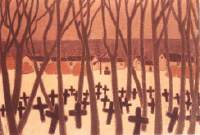
Members of Les Nabis who elected Rippl-Rónai to be one of them, thought that subject matters became equal once the third dimension was discarded, this way they thought to gain decorative qualities. "Only large contours are visible, forms are modelled little or hardly at all, clair-obscur is discarded, brushwork is cancelled, there is no space," summed up Emil Bernard the essence of their art. Many of Rippl-Rónai's pictures including the present one, follow Bernard's principles.
The simple drawing without any details sums up landscapes on both sides of the picture as if a skeleton, still the composition is closed and balanced. In spite of the gloomy atmosphere of the subject matter, Rippl-Rónai managed to catch the naive beauty of motifs simplified to their very essence, similarly to Gaugain who painted motifs of Bretagne: pictures of this kind approached reality with more emotions than works representing the main trend of the style. Greyish-brownish-purplish values hardly different from each other characteristic of Rippl-Rónai's colour reduction period, expressed the simultaneous presence of life and death, the melancholy of mortality present in other pictures, too, with a dimness and without any tools whatsoever.